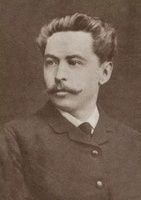Степанов Алексей Степанович (1858-1923) - живописец, график. Родился в семье военного, участника севастопольской обороны. Рано осиротел, детство провел в Разумовском филиале Сиротского института императора Николая I в Москве. Первоначальное художественное образование получил в Константиновском Межевом институте, который окончил в 1870. С 1880 посещал занятия в МУЖВиЗ, до 1883 как вольнослушатель, в 1883–1884 — постоянным учеником. Учился у И. М. Прянишникова, Е. С. Сорокина и А. К. Саврасова. В 1883 за рисунок и эскиз картины «Отец и сын, или Военная беседа» награжден малой серебряной медалью. Годом позже за одноименную картину был удостоен большой серебряной медали и выпущен из Училища со званием классного художника.
Жил в Москве. В 1883, когда Степанов еще учился в МУЖВиЗ, началось его сотрудничество с журналом «Природа и охота», продлившееся до 1895. Летние месяцы 1886–1887 он работал вместе с И. И. Левитаном и С. П. Кувшинниковой в Саввинской слободе под Звенигородом. В 1888–1889 путешествовал с ними по Оке и Волге, до Плеса. В те же годы познакомился с А. П. Чеховым. В 1894 совершил поездку по Европе, посетил Германию, Францию, Швейцарию, Северную Италию. В 1896–1897 неоднократно бывал в Крыму.
С 1885 участвовал в выставках Московского общества любителей художеств. В 1891 вступил в ТПХВ, став постоянным экспонентом выставок Товарищества до 1910 (с перерывами). Две работы Степанова с выставок ТПХВ в 1889–1890 и 1891–1892 были куплены П. М. Третьяковым. В 1900 экспонировал свои работы на Всемирной выставке в Париже.
С 1899 (до 1918) вел анималистический класс в МУЖВиЗ. В 1903 стал одним из основателей и активных участников выставок Союза русских художников (до 1923). В 1905 за картину «Утренний привет» избран академиком.
В 1905 путешествовал по югу Франции, в 1907 посетил Париж, Виши, Ментону, Трувиль, в 1912 — Финляндию и Крым. Летние месяцы с 1906 по 1914 жил и работал на озере Удомля в Тверской губернии. В 1911 экспонировал свои картины на Всемирной выставке в Риме, в 1914 — на Международной выставке в Мюнхене.
После революции продолжил активно работать и участвовать в выставочной деятельности. Работы Степанова были представлены на XVII выставке картин московских и петроградских художников в 1917 в Москве и в других экспозициях.
Ретроспективные выставки произведений мастера прошли в 1941 в выставочном зале Союза художников СССР в Москве, в 1948 — в Государственной Третьяковской галерее (совместно с С. А. Коровиным), в 1959 (приурочена к 100-летию со дня рождения) и 1976 — в Москве (места неизвестны).
Степанов — один из крупнейших пейзажистов и анималистов рубежа XIX–XX веков. В его раннем творчестве преобладали жанровые картины, выполненные в традициях передвижников под влиянием учителей — Прянишникова и Сорокина — и повествующие о событиях будничной жизни. Вместе с тем уже в них проявились поэтическое восприятие жизни и особая душевная теплота, отличающие лучшие произведения художника. В работах 1900-х — 1910-х особое внимание Степанов уделял передаче различных настроений природы: легкой грусти, умиротворенности, жизнерадостности. В своей живописи он использовал многие приемы импрессионистов, писал на пленэре в свободной манере, широко и эскизно. Излюбленной графической техникой художника была гуашь, непрозрачные краски которой имеют матово-бархатистый оттенок. Всего несколькими мазками ему удавалось очень точно передать в своих картинах световоздушную среду, подчас еле заметные изменения атмосферы. В картинах мастера поражает свежесть колорита и непосредственность живого восприятия, впечатление сиюминутности происходящего.
Творчество художника представлено в музейных и частных собраниях, в том числе в Государственной Третьяковской галерее, Государственном Русском музее, ГМИИ им. А. С. Пушкина.

